5-Amino-3-methyl-Isoxazole-4-carboxylic Acid as a Novel Unnatural Amino Acid in the Solid Phase Synthesis of α/β-Mixed Peptides
Abstract
:1. Introduction
2. Results and Discussion
2.1. AMIA Coupling to the Model Peptidyl Resin with the H-DVYT Sequence (1)
2.2. AMIA Coupling to the Model Peptidyl Resin with the H-EAAA Sequence (2)
2.3. AMIA Coupling to the Model Peptidyl Resin with the H-PPPP Sequence (3)
2.4. Coupling of Fmoc-Ala-OH to the Model Peptidyl Resin with the H-AMIA-PPPP Sequence (4)
3. Materials and Methods
3.1. Reagents
3.2. 5-Amino-3-Methyl-Isoxazole-4-Carboxylic Acid Synthesis
3.3. Fmoc-AMIA synthesis
3.4. Peptide Synthesis
3.5. ESI-MS and LC-MS Analysis
3.6. HPLC Analysis
4. Conclusions
Author Contributions
Funding
Institutional Review Board Statement
Informed Consent Statement
Data Availability Statement
Acknowledgments
Conflicts of Interest
Sample Availability
References
- Sysak, A.; Obmińska-Mrukowicz, B. Isoxazole ring as a useful scaffold in a search for new therapeutic agents. Eur. J. Med.Chem. 2017, 137, 292–309. [Google Scholar] [CrossRef] [PubMed]
- Zimecki, M.; Bąchor, U.; Mączyński, M. Isoxazole derivatives as regulators of immune functions. Molecules 2018, 23, 2724. [Google Scholar] [CrossRef] [PubMed]
- Kumbhare, R.M.; Kosurkar, U.B.; Janaki Ramaiah, M.; Dadmal, T.L.; Pushpavalli, S.N.; Pal-Bhadra, M. Synthesis and biological evaluation of novel triazoles and isoxazoles linked 2-phenyl benzothiazole as potential anticancer agents. Bioorganic Med. Chem. Lett. 2012, 22, 5424–5427. [Google Scholar] [CrossRef] [PubMed]
- Rajanarendar, E.; Rama Krishna, S.; Nagaraju, D.; Reddy, G.K.; Kishore, B.; Reddy, Y.N. Environmentally benign synthesis, molecular properties prediction and anti-inflammatory activity of novel isoxazolo[5,4-d]isoxazol-3-yl-aryl-methanones via vinylogous Henry nitroaldol adducts as synthons. Bioorganic Med. Chem. Lett. 2015, 25, 1630–1634. [Google Scholar] [CrossRef] [PubMed]
- Karthikeyan, K.; Veenus Seelan, T.; Lalitha, K.G.; Perumal, P.T. Synthesis and antinociceptive activity of pyrazolyl isoxazolines and pyrazolyl isoxazoles. Bioorganic Med. Chem. Lett. 2009, 19, 3370–3373. [Google Scholar] [CrossRef]
- Satyanarayana, P.S.; Jain, N.K.; Singh, S.; Kulkarni, S.K. Effect of selective inhibition of cyclooxygenase-2 on lipopolysaccharide-induced hyperalgesia. Inflammopharmacology 2004, 12, 57–68. [Google Scholar] [CrossRef] [PubMed]
- Grover, N.D. Echinocandins: A ray of hope in antifungal drug therapy. Indian J. Pharmacol. 2010, 42, 9–11. [Google Scholar] [CrossRef]
- Herrmann, M.L.; Schleyerbach, R.; Kirschbaum, B.J. Leflunomide: An immunomodulatory drug for the treatment of rheumatoid arthritis and other autoimmune diseases. Immunopharmacology 2000, 47, 273–289. [Google Scholar] [CrossRef]
- Suginome, M.; Tanaka, Y.; Hasui, T. Diarylborinic acid derivatives as a catalytic iminium ion generator in the mannich-type reaction using secondary amines, aldehydes, and ketene silyl acetals. Synlett 2008, 8, 1239–1242. [Google Scholar] [CrossRef]
- Müller, A.; Vogt, C.; Sewald, N. Synthesis of Fmoc-β-homoamino acids by ultrasound-promoted wolff rearrangement. Synthesis 1998, 6, 837–841. [Google Scholar] [CrossRef]
- Sibi, M.P.; Deshpande, P.K. A new methodology for the synthesis of β-amino acids. J. Chem. Soc. Perkin Trans. 2000, 1, 1461–1466. [Google Scholar] [CrossRef]
- Bąchor, U.; Mączyński, M. Selected β2-, β3- and β2,3-amino acid heterocyclic derivatives and their biological perspective. Molecules 2021, 26, 438. [Google Scholar] [CrossRef]
- Grauer, A.; König, B. Peptidomimetics–a versatile route to biologically active compounds. Eur. J. Org. Chem. 2009, 30, 5099–5111. [Google Scholar] [CrossRef]
- Aguilar, M.I.; Purcell, A.W.; Devi, R.; Lew, R.; Rossjohn, J.; Smith, A.I.; Perlmutter, P. Beta-amino acid-containing hybrid peptides—New opportunities in peptidomimetics. Org. Biomol. Chem. 2007, 5, 2884–2890. [Google Scholar] [CrossRef]
- Merrifield, R.B. Solid phase peptide synthesis. I. The synthesis of a tetrapeptide. J. Am.Chem. Soc. 1963, 85, 2149–2154. [Google Scholar] [CrossRef]
- Stevenazzi, A.; Marchini, M.; Sandrone, G.; Vergani, B.; Lattanzio, M. Amino acidic scaffolds bearing unnatural side chains: An old idea generates new and versatile tools for the life sciences. Bioorganic Med. Chem. Lett. 2014, 24, 5349–5356. [Google Scholar] [CrossRef]
- Rolt, A.; O’Neill, P.M.; Liangc, T.J.; Stachulski, A.V. Synthesis of MeBmt and related derivatives via syn-selective ATH-DKR. RSC Adv. 2019, 9, 40336–40339. [Google Scholar] [CrossRef]
- Craik, J.D.; Fairlie, P.D.; Liras, S.; Price, D. The future of peptide-based drugs. Chem. Biol. Drug Des. 2013, 81, 136–147. [Google Scholar] [CrossRef]
- Njogu, P.M.; Gut, J.; Rosenthal, P.J.; Chibale, K. Design, synthesis, and antiplasmodial activity of hybrid compounds based on (2R,3S)-N-benzoyl-3-phenylisoserine. ACS Med. Chem. Lett. 2013, 4, 637–641. [Google Scholar] [CrossRef]
- Weaver, B.A. How Taxol/paclitaxel kills cancer cells. Mol. Biol. Cell. 2014, 25, 2677–2681. [Google Scholar] [CrossRef]
- Djamshidian, A.; Poewe, W. Apomorphine and levodopa in Parkinson’s disease: Two revolutionary drugs from the 1950’s. Parkinsonism Relat. Disord. 2016, 33, S9–S12. [Google Scholar] [CrossRef]
- Uchino, H. Transport of amino acid-related compounds mediated by L-type amino acid transporter 1 (LAT1): Insights into the mechanisms of substrate recognition. Mol. Pharmacol. 2002, 61, 729–737. [Google Scholar] [CrossRef]
- Davis, P.J.; Leonard, J.L.; Davis, F.B. Mechanisms of nongenomic actions of thyroid hormone. Front. Neuroendocrinol. 2008, 29, 211–218. [Google Scholar] [CrossRef]
- Sharma, K.K.; Maurya, I.K.; Khan, S.I.; Jacob, M.R.; Kumar, V.; Tikoo, K.; Jain, R. Discovery of a membrane-active, ring-modified histidine containing ultrashort amphiphilic peptide that exhibits potent inhibition of Cryptococcus neoformans. J. Med. Chem. 2017, 60, 6607–6621. [Google Scholar] [CrossRef]
- Blaszczyk, R.; Brzezinska, J.; Dymek, B.; Stanczak, P.S.; Mazurkiewicz, M.; Olczak, J.; Nowicka, J.; Dzwonek, K.; Zagozdzon, A.; Golab, J.; et al. Discovery and pharmacokinetics of sulfamides and guanidines as potent human arginase 1 inhibitors. ACS Med. Chem. Lett. 2020, 11, 433–438. [Google Scholar] [CrossRef]
- Van Zandt, M.C.; Whitehouse, D.L.; Golebiowski, A.; Ji, M.K.; Zhang, M.; Beckett, R.P.; Jagdmann, G.E.; Ryder, T.R.; Sheeler, R.; Andreoli, M.; et al. Discovery of (R)-2-amino-6-borono-2-(2-(piperidin-1-yl)ethyl)hexanoic acid and congeners as highly potent inhibitors of human arginase I for treatment of myocardial reperfusion injury. J. Med. Chem. 2013, 56, 2568–2580. [Google Scholar] [CrossRef]
- Mallart, S.; Ingenito, R.; Bianchi, E.; Bresciani, A.; Esposito, S.; Gallo, M.; Magotti, P.; Monteagudo, E.; Orsatti, L.; Roversi, D.; et al. Identification of potent and long-acting single-chain peptidemimetics of human relaxin-2 for cardiovascular diseases. J. Med. Chem. 2021, 64, 2139–2150. [Google Scholar] [CrossRef]
- Bąchor, R.; Randaccio, E.; Lachowicz, J.I.; Stefanowicz, P.; Nurchi, V.M.; Szewczuk, Z. Synthesis and mass spectrometry analysis of mimosine-containing peptides. Int. J. Pept. Res. Therap. 2021, 27, 379–384. [Google Scholar] [CrossRef]
- Bąchor, R.; Dębowski, D.; Łęgowska, A.; Stefanowicz, P.; Rolka, K.; Szewczuk, Z. Convenient preparation of deuterium labeled analogs of peptides containing N-substituted glycines for a stable isotope dilution LC-MS quantitative analysis. J. Pept. Sci. 2015, 21, 819–825. [Google Scholar] [CrossRef]
- Wysocka, M.; Gruba, N.; Grzywa, R.; Giełdoń, A.; Bąchor, R.; Brzozowski, K.; Sieńczyk, M.; Jenne, D.; Szewczuk, Z.; Rolka, K. PEGylated substrates of NSP4 protease: A tool to study protease specificity. Sci. Rep. 2016, 6, 22856/1–22856/11. [Google Scholar] [CrossRef] [PubMed] [Green Version]
- Bąchor, U.; Drozd-Szczygieł, E.; Bąchor, R.; Jerzykiewicz, L.; Wieczorek, R.; Mączyński, M. New water-soluble isoxazole-linked 1,3,4-oxadiazole derivative with delocalized positive charge. RSC Adv. 2021, 11, 29668–29674. [Google Scholar] [CrossRef] [PubMed]
- Bąchor, U.; Ryng, S.; Mączyński, M.; Artym, J.; Kocięba, M.; Zaczyńska, E.; Kochanowska, I.; Tykarska, E.; Zimecki, M. Synthesis, immunosuppressive properties, mechanism of action and X-ray analysis of a new class of isoxazole derivatives. Acta Pol. Pharm. 2019, 76, 251–263. [Google Scholar] [CrossRef]
- Regiec, A.; Płoszaj, P.; Ryng, S.; Wojciechowski, P. Vibrational spectroscopy of 5-amino-3-methyl-4- isoxazolecarbohydrazide and its N-deuterated isotopologue. Vib. Spectrosc. 2014, 70, 125–136. [Google Scholar] [CrossRef]
- Regiec, A.; Wojciechowski, P.; Pietraszko, A.; Mączyński, M. Infrared spectra and other properties predictions of 5-amino-3-methyl-4-isoxazolecarbohydrazide with electric field simulation using CPC model. J. Mol. Struct. 2018, 1161, 320–338. [Google Scholar] [CrossRef]
- Wołczański, G.; Płóciennik, H.; Lisowski, M.; Stefanowicz, P. A faster solid phase peptide synthesis method using ultrasonic agitation. Tetrahedron Lett. 2019, 60, 1814–1818. [Google Scholar] [CrossRef]
- Szewczuk, Z.; Siemion, I.Z.; Wieczorek, Z. Immunological properties of the thymopentin-like fragments of HLA-DQ. Mol. Immunol. 1996, 33, 903–908. [Google Scholar] [CrossRef]
- Jones, J. Abbreviations and symbols in peptide science: A revised guide and commentary. J. Pept. Sci. 2006, 12, 1–12. [Google Scholar] [CrossRef]
- Yu, W.; Vath, J.E.; Huberty, M.C.; Martin, S.A. Identification of the facile gas-phase cleavage of the Asp-Pro and Asp-Xxx peptide bonds in matrix-assisted laser desorption time-of-flight mass spectrometry. Anal. Chem. 1999, 65, 3015–3023. [Google Scholar] [CrossRef]
- Unnithan, A.G.; Myer, M.J.; Veale, C.J.; Danell, A.S. MS/MS of protonated polyproline peptides: The influence of N-terminal protonation on dissociation. J. Am. Soc. Mass Spectrom. 2007, 18, 2198–2203. [Google Scholar] [CrossRef]
- Vaisar, T.; Urban, J. Probing the proline effect in CID of protonated peptides. J. Mass Spectrom. 1996, 31, 1185–1187. [Google Scholar] [CrossRef]
- Grewal, R.N.; El Aribi, H.; Harrison, A.G.; Siu, K.W.M.; Hopkinso, A.C. Fragmentation of protonated tripeptides: The proline effect revisited. J. Phys. Chem. B 2004, 108, 4899–4908. [Google Scholar] [CrossRef]
- Pedersen, S.L.; Tofteng, A.P.; Malik, L.; Jensen, K.J. Microwave heating in solid-phase peptide synthesis. Chem. Soc. Rev. 2012, 41, 1826–1844. [Google Scholar] [CrossRef]
- Upadhyay, A.; Chompoo, J.; Taira, N.; Fukuta, M.; Gima, S.; Tawata, S. Solid-phase synthesis of mimosine tetrapeptides and their inhibitory activities on neuraminidase and tyrosinase. J. Agr. Food. Chem. 2011, 59, 12858–12863. [Google Scholar] [CrossRef]
- Chan, W.C.; White, P.J. Fmoc Solid Phase Peptide Synthesis; Hames, B.D., Ed.; A Practical Approach Series; A Practical Approach; Oxford University Press Inc.: New York, NY, USA, 2000. [Google Scholar]
- Kaiser, E.; Colescott, R.L.; Bossinger, C.D.; Cook, P.I. Color test for detection of free terminal amino groups in the solid-phase synthesis of peptides. Anal. Biochem. 1970, 34, 595–598. [Google Scholar] [CrossRef]


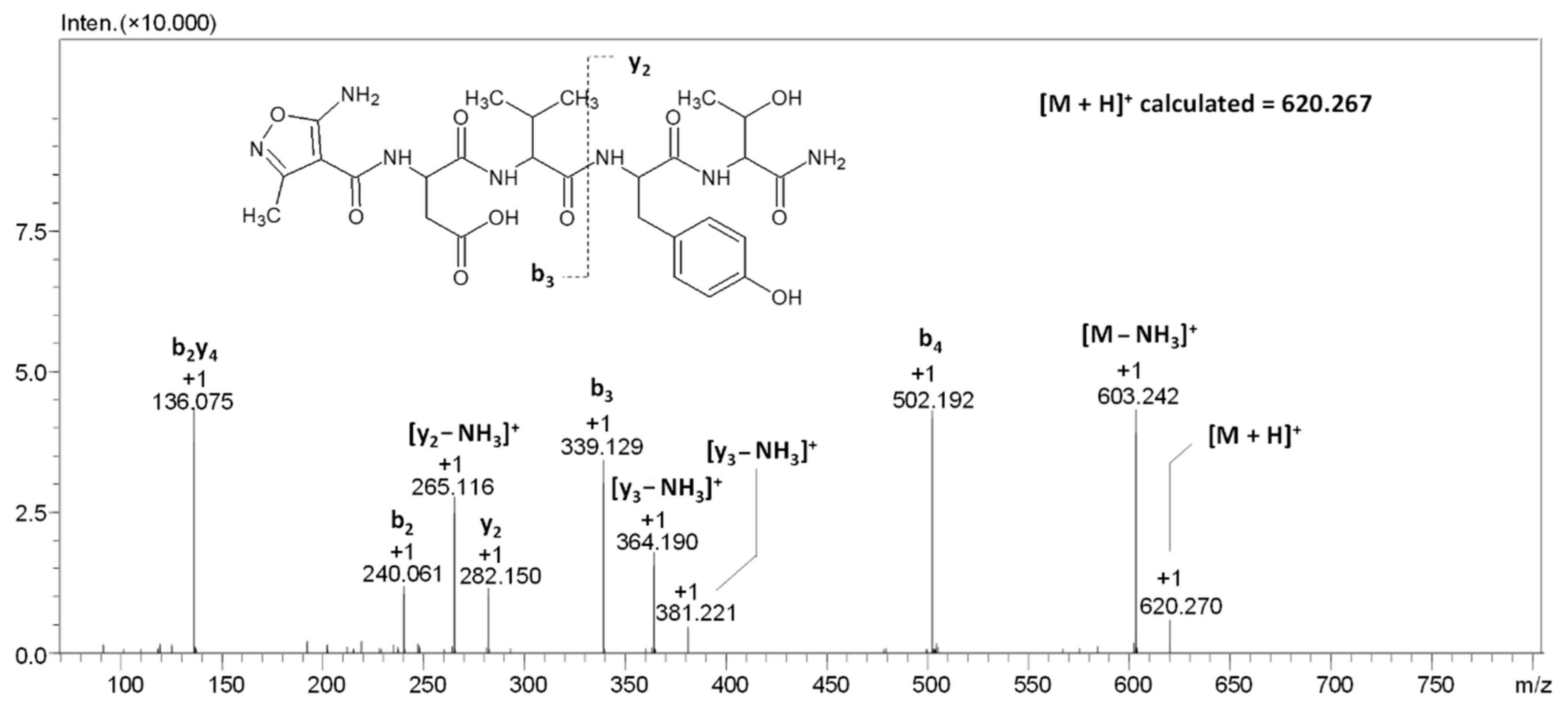
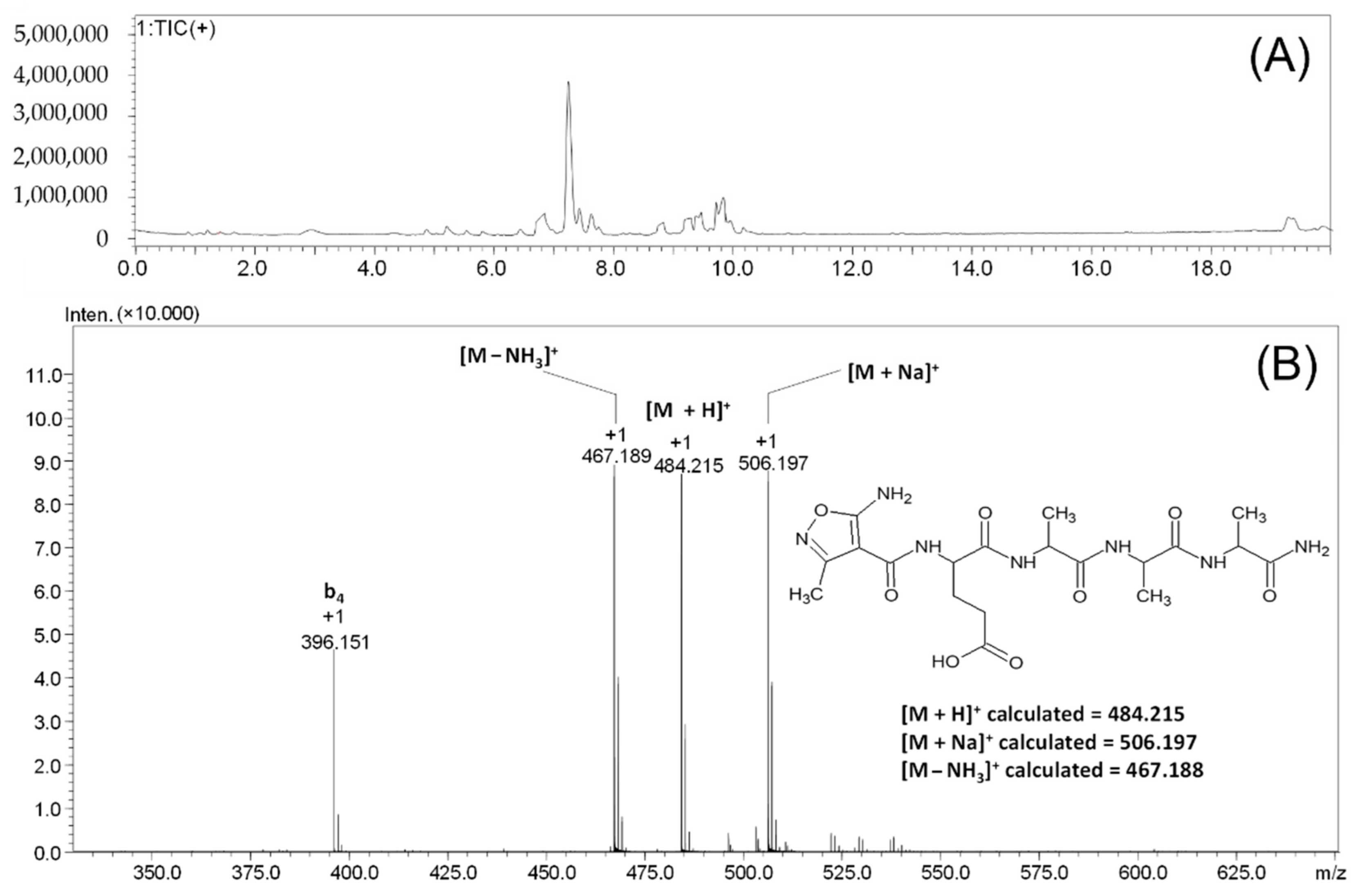
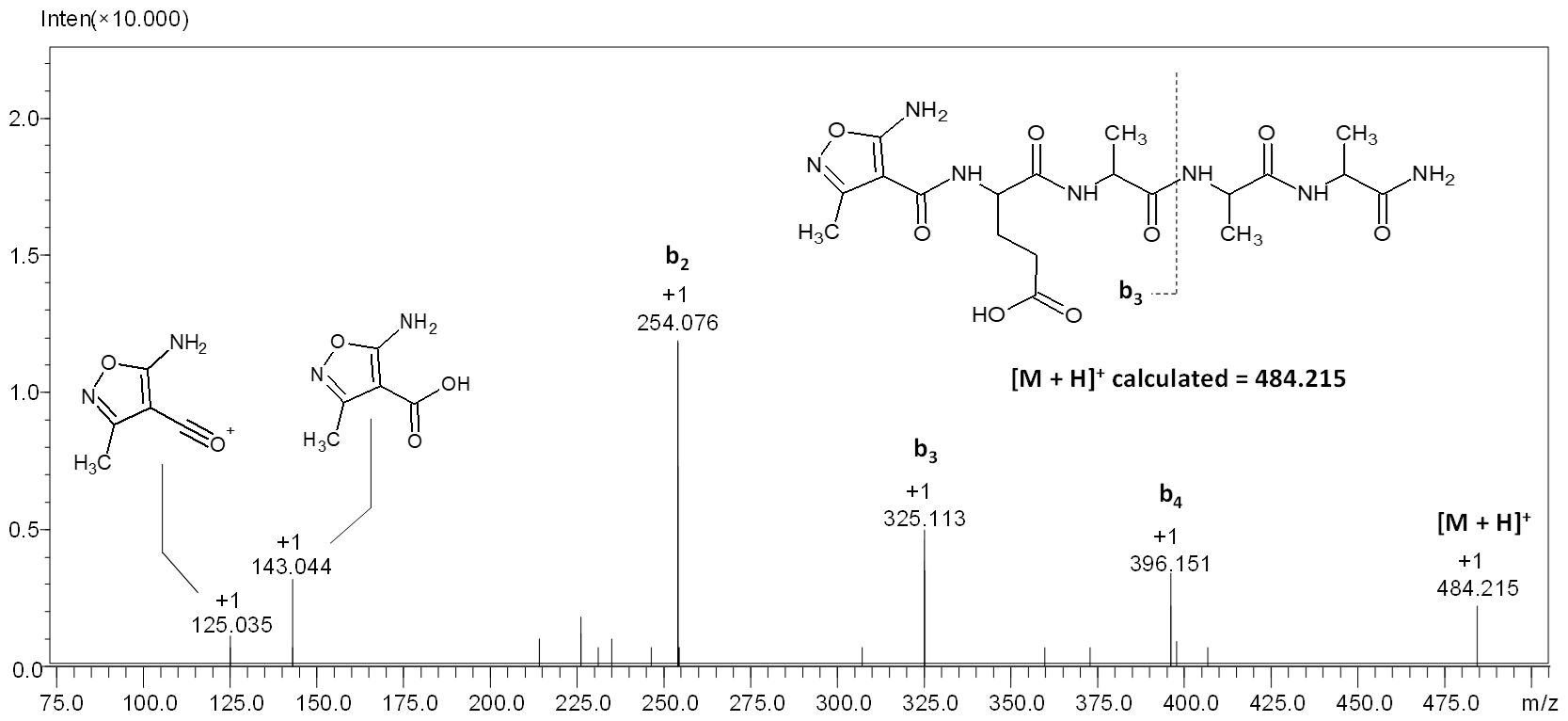


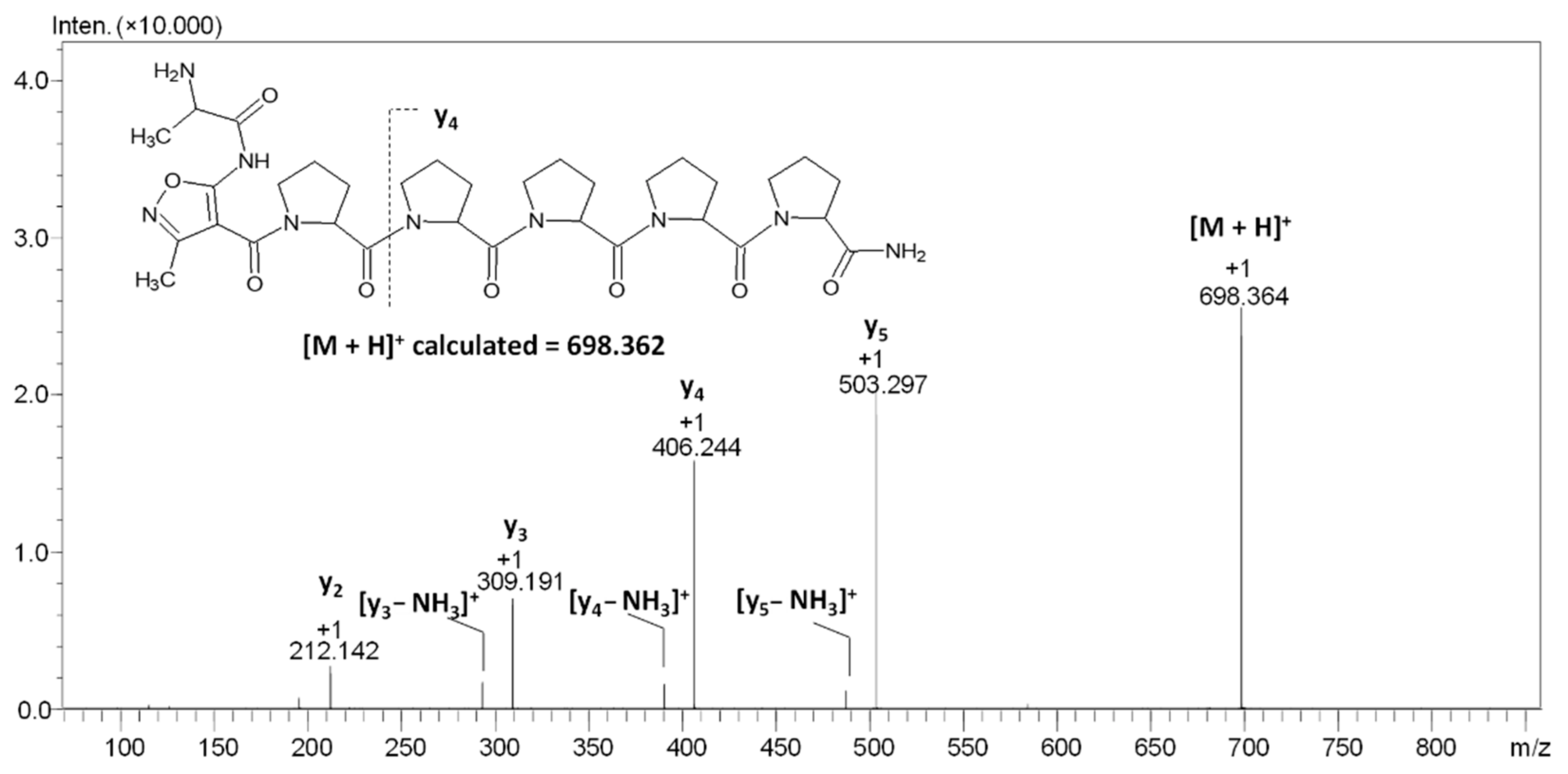

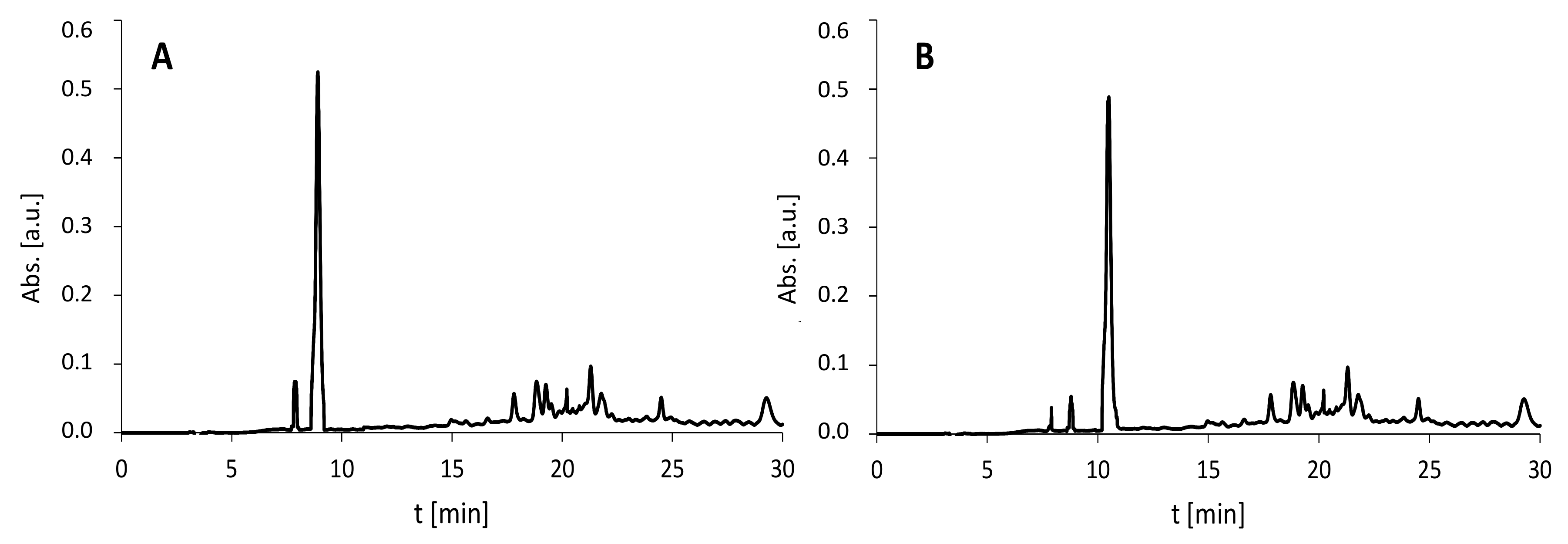
| Nr. | Peptide Sequence | [M + H]+ Found | [M + H]+ Calc. | [M + Na]+ Found | [M + Na]+ Calc. |
|---|---|---|---|---|---|
| 1 | H-AMIA-DVYT-NH2 | 620.267 | 620.267 | 642.250 | 642.249 |
| 2 | H-AMIA-EAAA-NH2 | 484.215 | 484.215 | 506.197 | 506.197 |
| 3 | H-AMIA-PPPP-NH2 | 530.276 | 530.272 | 552.258 | 552.254 |
| 4 | H-A-AMIA-PPPPP-NH2 | 698.364 | 698.362 | - | - |
Publisher’s Note: MDPI stays neutral with regard to jurisdictional claims in published maps and institutional affiliations. |
© 2022 by the authors. Licensee MDPI, Basel, Switzerland. This article is an open access article distributed under the terms and conditions of the Creative Commons Attribution (CC BY) license (https://creativecommons.org/licenses/by/4.0/).
Share and Cite
Bąchor, U.; Lizak, A.; Bąchor, R.; Mączyński, M. 5-Amino-3-methyl-Isoxazole-4-carboxylic Acid as a Novel Unnatural Amino Acid in the Solid Phase Synthesis of α/β-Mixed Peptides. Molecules 2022, 27, 5612. https://doi.org/10.3390/molecules27175612
Bąchor U, Lizak A, Bąchor R, Mączyński M. 5-Amino-3-methyl-Isoxazole-4-carboxylic Acid as a Novel Unnatural Amino Acid in the Solid Phase Synthesis of α/β-Mixed Peptides. Molecules. 2022; 27(17):5612. https://doi.org/10.3390/molecules27175612
Chicago/Turabian StyleBąchor, Urszula, Agnieszka Lizak, Remigiusz Bąchor, and Marcin Mączyński. 2022. "5-Amino-3-methyl-Isoxazole-4-carboxylic Acid as a Novel Unnatural Amino Acid in the Solid Phase Synthesis of α/β-Mixed Peptides" Molecules 27, no. 17: 5612. https://doi.org/10.3390/molecules27175612
APA StyleBąchor, U., Lizak, A., Bąchor, R., & Mączyński, M. (2022). 5-Amino-3-methyl-Isoxazole-4-carboxylic Acid as a Novel Unnatural Amino Acid in the Solid Phase Synthesis of α/β-Mixed Peptides. Molecules, 27(17), 5612. https://doi.org/10.3390/molecules27175612














